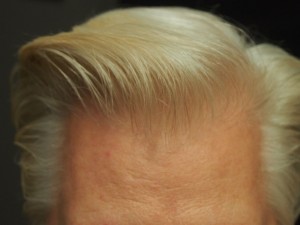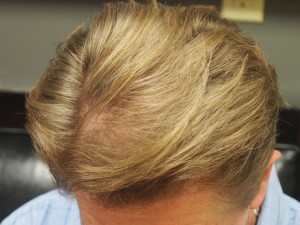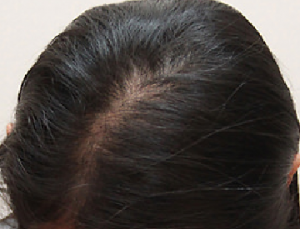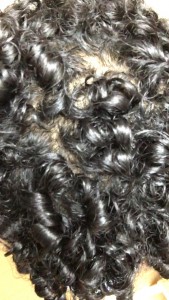Finasteride does not work in the treatment of alopecia areata as this disease is an autoimmune disease and has nothing to do with the DHT metabolic pathway.
https://stemcellstm.alphamedpress.org/content/early/2015/09/23/sctm.2015-0107.abstract
The single best test for hair regrowth is the HAIRCHECK test which measures actual bulk. Photographic evaluation is not accurate, in my opinion, in determining the effects for the treatment, although it is suggestive of value. PRP (Platelet Rich Plasma injections) has not been standardized. In fact, the preparation of the PRP solution varies widely such that many of the effluent taken does not maximize enough stem cells. Some groups of doctors are trying to standardize PRP. I have been hesitant to blindly start performing PRP, but pressure continues on patients coming to my practice asking for it. The good news is that if I decide to offer this treatment, I will be able to perform HAIRCHECK instrument checks to validate if it works.
These patches reflect a disease called Alopecia Areata. You can read about it here: https://en.wikipedia.org/wiki/Alopecia_areata
We have treated many of these men cosmetically with scalp micropigmentation. It hides the problem for them.
if the disease is limited, scalp micropigmentation works well keeping the hair lonhg to cover the bald spots, but when it gets advanced and the long hair can’t cover the balding spots, then a person can shave his head and hide the disease as the scalp micropigmentation fills in the bald patches with ‘dots’ that look like a shaved hair follicle. The disease can come and go, so having the scalp micropigmentation covering their entire scalp, gives them the opportunity to socially manage their hair loss when the disease is in its worst presentation. The decision to do Scalp Micropigmentation is a personal one, made when the patient feels that he can’t deal with the appearance of the disease. See: https://scalpmicropigmentation.com/
Multiple articles have been appearing in scientific and medical journal lately that show that the infusion of blood from young people into older people can improve brain function in people with aging diseases of the brain including dementia. In the recent issue of New Scientist, a small article reflecting work done at Stanford University in California where human blood was collect from people of different ages and then the plasma was infused into mice whoch were, in human terms, 50 years old. The greatest effect was seen when human cord blood from babies umbilical cord was used. The mice learned better and faster and show enhanced activity in the part of the brain called the Hippocampus, the part of the brain responsible for learning and memory.
After 8 months on .25 mg finastride and 5% Minoxidil, I notice an increase in my sex drive, watery semen and nipple tenderness. I masterbate 4-5x per day, double my usual count. I have been taking Finastride since 2014 (1.25 mg) but reduced the dosage due to sides. Sometimes I feel Finastride effects me emotionally. I feel very irritated, loss of focus, minor speech problems and experience depression, all of which I have no proof if it is related to the Finastride. My hair has gotten much thinner in the last year too. Is it recomended to stay on this medication with these side effects or what I percieve as side effects? Should I stay on it for a whole year to see if the side effects go away? I was in much bad shape before I decided to take a lower dose and now I feel much better but I am worried about my health because I am not as mentally sharp as I used to be.
You are already taking 1/4 of the dose of finasteride which is only 50% as effective of the full dose. I doubt that you will see a better result of the finasteride by dropping the dose further. I have a few patients that report an increased sex drive on the drug but few complain about it. Maybe your sex drive will decrease with a lower dose. I think that you should you go back to your doctor and ask your doctor if this is the drug approach for you. It sounds to me like you have too many side effect which you are ascribing to the drug finasteride, a good reason to stop it.
You have short bangs and have had them many, many years (over 30 years). I suspect that your frontal 1/2 inch of your hair line has a short anagen cycle reflecting the fact that the bangs do not grow to length beyond just a few inches. This is your genetics and there is nothing that can be done for it
For women with hair loss, I generally recommend a medical work-up with lots of blood tests and a good history looking to see if you are taking birth control pills, for example, which is a prime suspect in female hair loss. If you have CTE because you have ruled out the other causes of hair loss, then patient may be the best approach as most cases of CTE, eventually resolve on their own in a year or two.
The work-up for women is described in this former post here on balding blog: https://baldingblog.com/2009/03/13/woman-with-handfuls-of-hair-that-come-out-every-morning/
Triggers for alopcia areata are many, stress being one but most of the time there is no known trigger. Alopecia areata has genetic markers which indicate a genetic link. Just go on with your life, stop worrying because worrying increases your stress.
The balding genes come from either side of the family, but even if you inherit it, the genes may not express themselves and therefore leave you with a full had of hair. Anything is possible.
This man, in his mid-50s with white hair, corrected me and told me it was Arctic Silver, so I laughed point out that I put it there. We decided a bit more frontal density would do wonders for him and he agreed.
This friend also had his hairline created by me 11 years ago. These two men get complements on the way their hair looks all of the time. He does not need further work.
I am assuming that you are a female and that you have some form of female hair loss. To get a diagnosis for cause, you needs medical tests which are defined in this post here: https://baldingblog.com/2009/03/13/woman-with-handfuls-of-hair-that-come-out-every-morning/. You can treat this cosmetically with scalp micropigmentation, something that my daughter-in-law did with us. See here for examples: https://scalpmicropigmentation.com/smp-for-women/
To answer this question, you would need to have a doctor check you with an instrument called HAIRCHECK which will show the hair bulk in different parts of your scalp with good clinical numbers ascribed to each measurement. If you were balding, it would take significant hair loss before you would know because of your curly hair which would certainly hide the balding in its early stages. See a doctor if you really care to find out the answer to your question.
I usually cut a ~10 day supply but the last couple of months. I feel like finasteride doesn’t do anything since I started doing this. For the first months I used to have watery semen and sometimes feel slight reduction of my sex drive but the last couple of months I have ZERO side effects and I’m curius if cutting pills causing them to lose effectiveness after some days.
It is not unusual for people on finasteride to have their body normalize and see that the side effects disappear in the first 1-3 months, much like you discussed. If you keep the pills in a sealed pill bottle so that moisture does not get to it, then it will hold for months.
Your question is basic to hair science. Your question is like asking me to prove that the earth rotates around the sun. It can be proven, but it takes a bit of science and you must be open minded.
A Harvard researcher reported: “The promise of regnerative medicine to grow human tissue outside the body using pluripotent stem cells and to use that tissue to treat diseases such as diabetes has shown significant potential. But recent work by Harvard researchers determined that human pluripotent stem cells are prone to develop mutations in the TP53 gene, which ordinarily helps suppress cancer. The mutated versions of the TP53 found by the Harvard team, however, tend to drive cancer development suggesting the need to screen lab-grown stem cells for deleterious mutations.”
Doctor and patients are excited about the use of stem cells, but this finding certainly puts the brakes on the use of stem cells in certain situations by raising ‘a red flag’ highlighting the down side of these stem cells.
Page 6 of 7







